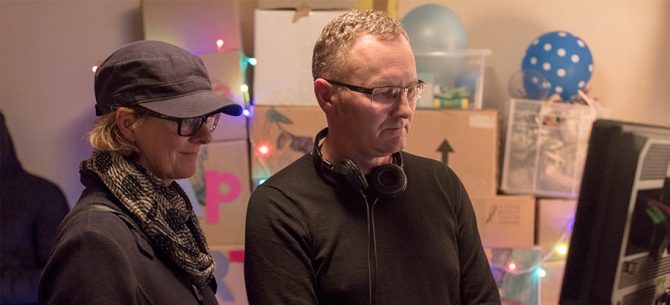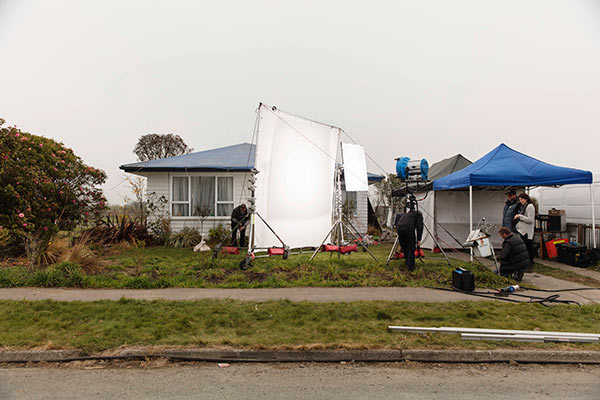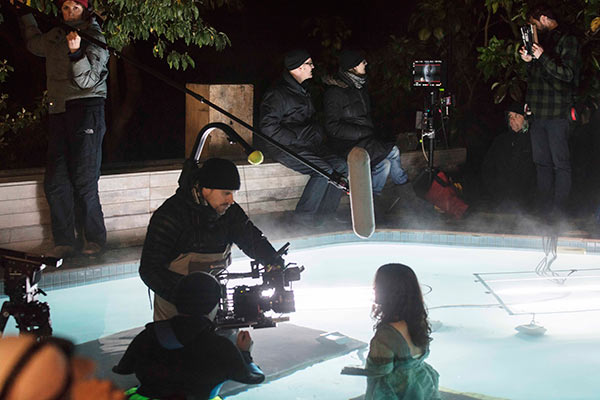Margaret Mahy's young adult novel, The Changeover was already several years old when I first picked up a worn copy in my high school library at the age of 15.
I was so taken with it that even before I had finished reading it I was re-imagining it in my head as a movie.
In that peculiarly obsessive way that teenage girls sometimes are about their favourite things my mania lead me to imagined locations and camera angles, and I had a very long list of songs to be included in the soundtrack. Most of which, upon reflection, were terrible.
When Margaret Mahy died in 2012, I felt moved to write a heartfelt blog post about how important her writing, and this book in particular, had been to me.
A couple of years later at a WORD Christchurch panel discussion on The Changeover, I learned that a film of the book was in development and felt conflicted in that way that book fans often do. Because how could that film ever live up to the book, or indeed my own imaginary movie of it?
Stuart McKenzie is, with his wife Miranda Harcourt, co-director of that film which recently finished shooting here in Christchurch.
Perhaps not fully understanding the degree of my fangirl obsession, he agreed to answer some questions about what their version of Mahy's story will look like.
Margaret Mahy wrote a number of terrific books for young adults – what made you want to film The Changeover particularly?
We felt The Changeover was really cinematic. It’s a supernatural thriller about a troubled teenager who’s got to change over and become a witch in order to save her little brother from an evil spirit. So, it’s got a great central conflict! And its genre is very clear — yet at the same time it puts this compelling twist on it by feeling very naturalistic.
Its themes of love, loss, sacrifice and change are primal. Laura Chant feels like a real person — she struggles with herself and her kind of dispossessed place in the world, but she’s got big dreams. In other words, she’s a complex and powerful heroine who our audience can really identify with!
Another thing that made the book feel so cinematic for us was Christchurch. We updated Margaret’s story to contemporary, post-earthquake Christchurch. For us, the brokenness and reconstruction of Christchurch is like a visual metaphor for Laura’s own damage and subsequent transformation.
The book (and Margaret Mahy herself) are very beloved, by me and many others. Does that place extra pressure on you to do a good job with the film?
All along we’ve wanted to make something Margaret would love: raw and lyrical, tender and tough and true. We wanted to keep the story feeling very contemporary, as the book itself was when it was first published in 1984. Like Margaret, we wanted to find the magic in the real world, not drift away into fantasy.
We were lucky to have Margaret’s blessing from the start. Before she died, she read and loved an early draft of the screenplay. So that was a great feeling to carry through the development of the project and into the shoot itself. She really encouraged us to find the spirit of the story and not be bound by the literal form of the book. We had this quote in mind by the great French film director Jean Renoir, “What interests me in adaptation isn’t the possibility of revealing the original in a film version, but the reaction of the film maker to the original work.”
I guess you could think of the book and the film as two reflecting worlds — much in the same way that Laura herself discovers the connectedness between two powerful realities — magic and the everyday — and finding in fact that they’re really one and the same.
Margaret was always clear that Laura’s changeover into a witch is a metaphor for her becoming a young woman, an active journey to embrace her own creative power. And Laura’s story itself is a metaphor for the challenges we all face in our lives and the changeovers we all have to go on in order to grow.
Oh yeah, back to the question about doing a good job… Yes, we really feel that! And we’ve still got a lot of work to do in post-production. Helps to have great people to work with, which we have.
On the one hand The Changeover, if you’re familiar with Christchurch, is very recognisably placed here, on the other hand it’s also very vague about where it’s set. The name of the city is never mentioned. The suburbs and street names in it are all made up. Christchurch is certainly its spiritual home, but you could make a very good argument that it’s not a story that needs to be specifically told here, and yet you are telling it here. What made you want to shoot here rather than in Auckland or “Wellywood”?
As you say, Christchurch is the “spiritual home” of The Changeover and we always wanted to make it here. I was born and bred in Christchurch and spent my early teenage years in Bishopdale which Margaret calls Gardendale in the book.
The Changeover was welcomed to Christchurch by Ngai Tahu in a moving whakatau — as a production we felt hugely embraced by Christchurch, the people, the Council, the environment itself.
Miranda and I were determined to film in Christchurch because its flat vistas give the film a unique look. Cinematographer Andrew Stroud and Production Designer Iain Aitken helped us reflect the everyday and often unexpected beauty of the place.
Christchurch also allowed us to explore the division between social worlds which is a key feature of The Changeover. Laura comes from a solo-parent family struggling to make ends meet. By contrast, Sorensen Carlisle lives in an architect-designed home with fine art on the walls and a sense of history and sophistication. The developing romance between Laura and Sorensen means first differentiating and then bridging these two worlds.
Mahy herself described The Changeover as having a lot of folk tale elements - there are “evil” step-parents and an enchanted brother, for instance - but also that “the city is simultaneously a mythological forest”. Will your film retain those suggestions of a modern day fairy tale?
Yes it does and that is in the very DNA of the story. At heart The Changeover is an emotionally powerful female rite-of-passage keyed into a primal fairy tale tradition. It’s true that those fairy tale elements are more overt in Margaret’s novel.
We wanted the film to feel very contemporary and naturalistic so in our story the fairy tale nature is felt rather than seen. We often thought about Bruno Bettelheim’s groundbreaking study on fairy tale called The Uses of Enchantment. He says, “This is exactly the message that fairy tales get across to the child in manifold form: that a struggle against severe difficulties in life is unavoidable, is an intrinsic part of human existence — but that if one does not shy away, but steadfastly meets unexpected and often unjust hardships, one masters all obstacles and at the end emerges victorious.” That is something we experience through Laura in The Changeover.
In terms of characters, it strikes me that Sorensen Carlisle, at least how he’s written in the book, is something of a contradictory figure – dangerous yet vulnerable, jovial yet dark, aloof yet intense – that must present some challenges when it comes to casting. How difficult was it to find someone who can be all those things in a convincing way?
We had great casting agents in NZ and in the UK. We looked long and hard to cast this film. When we auditioned young UK actor Nick Galitzine we knew we had found our mysterious and compelling Sorensen Carlisle. And Nick and Erana James who plays Laura Chant have a powerful chemistry together. We have always said that this intensity is our special effect!
Reading the book as a teenager it was incredibly important to me that Laura was of mixed racial heritage both in a personal sense, as it was quite unusual to read about someone like me as the heroine of a novel, but also in that it marks her as being different and something of an outsider, which I think adds to her story. I’m really pleased that you’ve cast a part-Māori actress in the role. Was that always the plan?
This was totally important to us too. We love how in the book Laura is part-Maori but Margaret Mahy doesn’t make a big thing about that, it’s simply part of the unique world of the story which in fact helps make it feel universal. It’s true that Laura being part-Maori means that by her very nature she finds herself between two worlds. That’s the journey Laura is on — to open herself to new worlds, new experience.
We looked for many years for our Laura Chant — and we kept coming back to Erana James who we had met early on in our process. Of course, financiers want to cast someone in a central role like this who already has a profile. Erana hadn’t acted in a film before so she was unknown in NZ let alone internationally. But with the support of the NZ Film Commission we made a “tone reel” last year with Erana playing Laura. She was fantastic in it — and the international people involved in the project — like our sales agent and even Tim Spall or Melanie Lynskey — could immediately see that this young woman had something special.
Could you hope for a better villain than Timothy Spall?
You are so right! But what drew us to Tim in the first place is that he could reveal the humanity in Carmody Braque. It’s this which makes him such a powerful adversary for Laura — because there is something of Braque in Laura herself. A desire to live more fully and expand her horizons.
We are so lucky to have Timothy Spall in The Changeover. He is mesmerising. I think Margaret Mahy would have been thrilled!
It's clear from his answers that Stuart McKenzie is as much a fan of The Changeover as I am, so I feel much more relaxed about the movie adaptation now.
In addition to the film coming out late next year, McKenzie says there will also be a movie tie-in reprint of the (currently out of print) book. So roll on 2017!







Add a comment to: Book to film: The Changeover